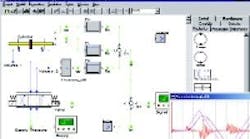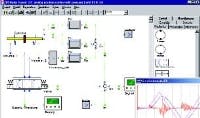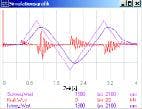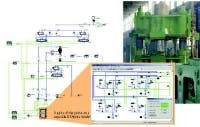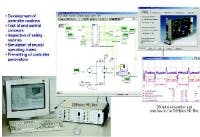If you're like most designers and engineers, you have a healthy backlog of projects in the works at any given time, and computers are indispensible in helping you push much of this work through the pipeline. Simulation is one such tool that shortens development time by allowing system operation and behavior to be studied before any metal is cut for prototypes.
One such simulation software designed by fluid power and software experts to simplify the simulation process without sacrificing accuracy or detail is DSHplus, from Fluidon GmbH. DSH-plus simulation software provides dynamic calculation of complex hydraulic and pneumatic components and entire systems. It combines experience in computer-based design tools with high-level engineering know-how to support projects from concept to actual use of a system.
Capabilities at a glance
Graphically based DSHplus describes a system as component parts of the central element of a model. Libraries contain hydraulic, pneumatic, and thermohydraulic components, as well as electric, control, and mechanical elements. The ensuing circuit analogy builds a simulation model intuitively and helps users quickly become familiar with the software.
Setting parameters of component parts is not complicated and is an essential precondition for accepting the simulation in industrial practice. Therefore, catalog data from manufacturers constitute the basis for the modeling of component parts. In addition, an open mathematical description of the system as C++ source code allows users to include their own description of any component part. This code can also interface with other simulation tools.
Because DSHplus is implemented on PCs, it can be used without additional investment in hardware or software at most workplaces.
Simulation in the works
A user draws his own models starting from a central project management, which eliminates having to handle files. Graphic modeling is circuit-oriented, but the graphical user interface is Windows-compatible. Therefore, a user can begin the simulation process without first receiving extensive training.
To draw a new simulation model, the user chooses elements for the system from the appropriate libraries and drags them onto a worksheet. Linking the connections with the mouse connects the individual elements. Without further assistance, the software intuitively inserts the correct connection type — hydraulic, pneumatic, mechanical, or electrical signal.
Parameters of the simulation model are set one component part at a time. Verified data sets of one component part can be saved in a database and loaded again. Thus, the user can record parameter sets of components with different sizes and from different suppliers for use in future projects.
The simulation starts once the required parameters have been entered. Two different onlineoutput modes are provided to control the simulation. One is a dynamic numerical display of the calculated values, and the other is a graphical display of selected variables (pressures, strokes, signal processes, etc.) in one or several output windows.
Typical applications
DSHplus is designed for the simulation of fluid-technical systems and adjoining technical domains such as mechanical and electrical or electronic components. System can mean an entire hydraulic or pneumatic system or a single component or group of components. The libraries offer components with various complexities for the different systems. Bandwidth may accommodate anything from systems with a simple static pressure relief valve to one with a detailed hydromechanical valve with pilot stage.
Examples of industrial and automotive applications prove the flexibility and the versatility of the software. For example, it has been used to model and simulate:
- the roller adjustment in a cold-rolling mill,
- an ingot mold oscillation drive controlled by servohydraulics,
- the overall control cycle of a forging press for optimization,
- active suspension systems,
- hydraulic actuation of a variable camshaft, and
- oscillation characteristics of pipes and hoses of a power steering unit.
Integrated virtual engineering
One way of reducing development time is through virtual prototyping techniques, where a simulation model replaces a physical prototype. Not only is development more rapid, but costs are lower and a greater number of design alternatives can be evaluated.
However, fluid power systems never work alone. They always operate in conjunction with mechanical systems, and usually with electrical, electronic, and sometimes other fluid power systems.
Unfortunately, each of these subsystems often are designed using different software, which can complicate virtual prototyping of an entire system. The consequences are that engineers must use several different tools and model different aspects of their design with different software tools. Therefore, original equipment manufacturers want an integrated approach for efficient virtual engineering of their mechatronic systems.
DSHplus serves this need with its Simulation Tool Chain (STC) option. The STC is designed for integrated virtual engineering of mechatronic systems, including hydraulic and pneumatic sub-systems. System developers using the STC can concentrate on the application at hand by taking advantage of the full functionality of DSHplus analysis and documentation tools.
The Simulation Tool Chain
Different interfaces of the Simulation Tool Chain can be used at any time to integrate characteristics of the fluid power sub-system into the overall scope of a project. Consequently, project coordination can strategically distribute individual tasks to ensure an effective, swift, and cost-effective development.
After the system has been set up, a DSHplus model is integrated into the overall project by means of a co-simulation interface. However, if a system becomes too complex, or individual sub-systems are configured completely, the STC can export the simulation model as series of equations or as a DSHplus Stand-alone Module.
Because STC interfaces for cosimulation and an embedded mode of standalone modules are one and the same, the simulation model can be linked to different target simulation environments without having to make any changes to it.
A major benefit of the STC functionality is that the verified fluid power sub-systems can be distributed to colleagues or project partners together with the simulation model. A copy of DSHplus is not needed on each target machine. Instead, only a runtime license for each computer using the export result is needed.
Currently, DSHplus STC Targets are available for:
- MATLAB/Simulink,
- LMS Virtual.Lab,
- MSC.ADAMS,
- SIMPACK,
- dSPACE,
- DIAdem,
- fuzzyTech, and
- NeuroModel.
Hardware-in-the-loop and real time applications
A variety of program interfaces also exists for DSHplus — notably, DSHplus-RT and DSHplus HIL Box. RT modules can be exported with the click of a button to provide complex, precisely detailed fluid power models for Hardware-in-the-Loop applications. DSH-plus HIL Box is used to interface the DSHplus fluid power simulation — including mechanical system parts — with real-world controller hardware. A fluid power engineer can use DSHplus HIL Box to develop and test complex control concepts directly on the target control hardware even if no mechanical system hardware has been built.
Coupling a hardware controller to a DSHplus simulation model makes it possible to determine initial controller gains for system startup beforehand. This means critical operating conditions can be tested safely, and failure analysis performed without risk.
DSHplus offers a variety of interfaces to support a stand-alone, fluid power specific system development, or a convenient model preparation and exchange for a mechatronic simulation approach.
For more information, e-mail [email protected] or visit www.fluidon.com.
